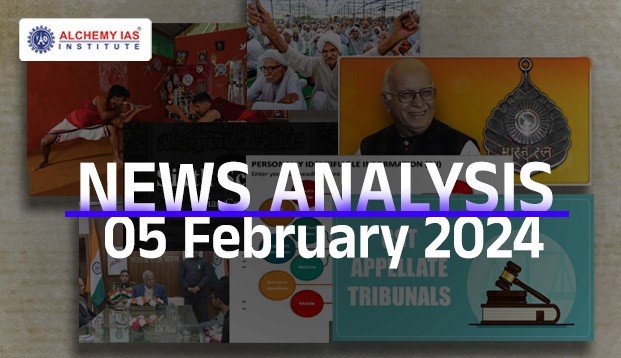| CONTENT LIST | ||
| Topics | Syllabus | |
| 1 | Kalarpayattu | GS.1: Art & Culture: Martial Arts in News |
| 2 | Khap | GS.1: Society – Traditional institutions |
| 3 | Resignation of Governor | GS.2: Indian Polity: State Executive |
| 4 | Sixth Schedule | GS.2: Indian Polity: Schedules of Indian Constitution |
| 5 | Bharat Ratna | GS.2: Indian Polity – Awards in News |
| 6 | Personally Identified Information | GS.2: Governance – E-governance |
| 7 | GST Appellate Tribunal | GS.2 & GS.3: Governance & Economy – Tax Reforms |
KALARIPAYATTU
Syllabus: GS.1: Art & Culture: Martial Arts in News
Why it’s in the News: Kalaripayattu gains traction in Haryana since its inclusion in the Khelo India games alongside other traditional Indian martial arts.
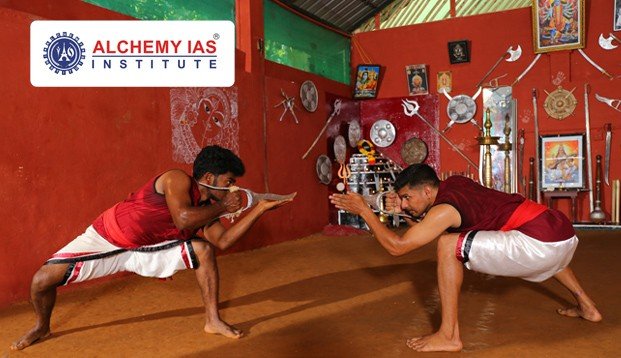
About Kalaripayattu
- Historical Roots:
- Derived from the Sanskrit word Khalurika, meaning “battlefield” or “threshing floor”, Kalaripayattu is among the oldest martial arts still practiced globally, with roots tracing back to Kerala around 200 BCE.
- Known as the “Mother of Martial Arts”, Kalaripayattu emphasizes self-discipline, respect, and spiritual connection, distinguishing it from mere fighting styles.
- Initially practiced by Kerala’s warrior class for land protection, it thrived during the 100-year war between the Cholas, Cheras, and Pandyas in the 11th century.
- British colonial rule in the 19th century saw its ban, fearing revolt, leading to its decline.
- However, in the late 20th century, Kalari regained popularity as part of promoting South Indian traditional arts.
- It is presently practiced in portions of Kerala and Tamil Nadu.
- Distinctive Features:
- Kalari centers, resembling temples, host rigorous training sessions emphasizing reflex development and mastery of weapons.
- This personal combat system encompasses reflex development for unarmed combat and mastery of various weapons like sticks, daggers, and swords, noted for its acrobatics and graceful movements, mirroring animal fighting techniques.
- Styles:
- Vadakkan (Northern) Style: Emphasizes graceful movements and weaponry, prevalent in Malabar, Kerala.
- Thekken (Southern) Style: Focuses on powerful techniques and unarmed combat, predominant in Travancore.
- Influence on Art Forms:
- Kalaripayattu’s fluid movements inspire traditional dances like Kathakali and Kolkali, enhancing performers’ flexibility and grace.
- Techniques like Uzhichil, a body massage integral to Kalari training, are sought after by artists for physical agility improvement.
Kalaripayattu remains not just a martial art but a cultural legacy, enriching diverse artistic expressions across India.
KHAP
Syllabus: GS.1: Indian Society – Traditional institutions
Why it’s in the News: Vice President Jagdeep Dhankhar on Saturday said “khap is our culture and a symbol of the depth of our civilisation”, and it cannot be evaluated on the basis of some isolated incidents.
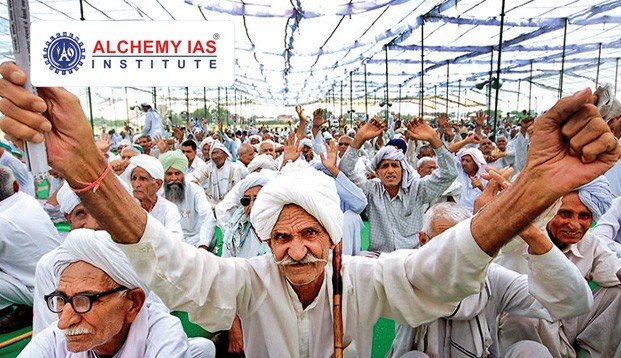
What is a Khap?
- Khaps are social organizations primarily composed of gotra-based clans, tracing their lineage to a common ancestor, and are regionally oriented.
- They are named based on either the number of villages or clusters of villages they represent, or the specific gotras they encompass.
- Historically, Khaps served three main functions: resolving familial and village disputes, upholding religious and social customs, and defending the community from external threats.
- Today, Khaps primarily focus on dispute resolution and ensuring adherence to social and religious norms within their areas.
- Leadership within Khaps is fluid, with no fixed organizational structure.
- While succession was traditionally hereditary, it’s now often determined on the spot, leading to disputes over leadership.
How many khaps are currently functional?
- There are approximately 300 main Khaps in North India, spanning states like Haryana, Uttar Pradesh, Delhi, Rajasthan, and Uttarakhand.
What is their social importance?
- In rural North India, Khaps wield significant influence in resolving local disputes, including marital, land, and familial issues.
- They intervene when parties fail to resolve matters independently and can impose penalties like social boycotts and fines.
- However, Khaps have faced criticism for their controversial rulings, particularly concerning inter-caste and intra-gotra/intra-village marriages.
- Criticized as “kangaroo courts,” they’ve been accused of enforcing regressive customs and even perpetrating honor killings, though Khap leaders deny this.
- Despite this, some Khaps have advocated for inter-caste marriages while pushing for legal amendments to ban same-gotra and same-village unions under the Hindu Marriage Act.
Adopting a nuanced perspective is imperative to acknowledge and honor the constructive elements of Khaps, while simultaneously rectifying their deficiencies to foster a society that is more inclusive and fair for all.
RESIGNATION OF GOVERNOR
Syllabus: GS.2: Indian Polity: State Executive – Office of the Governor
Why it’s in the News: Punjab Governor and Chandigarh Administrator Banwarilal Purohit resigned on Saturday, citing “personal reasons”.
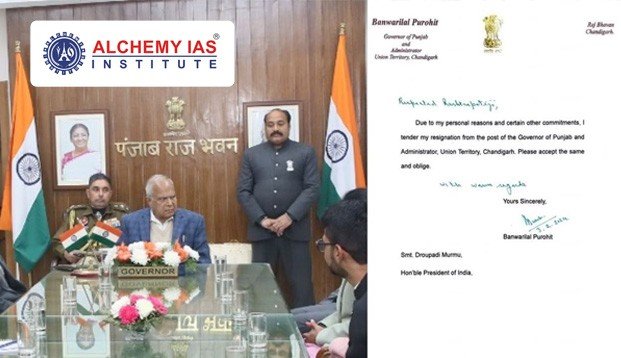
Resignation of Governor
- Term of Office:
- A governor’s tenure spans five years from the date of assuming office. However, this term of five years is subject to the pleasure of the President.
- Notably, the Supreme Court has asserted that the President’s discretion in this matter is beyond judicial review.
- The President holds the authority to transfer a Governor from one state to another for the remainder of their term.
- Governors do not enjoy fixed tenures or tenure security, as they may be removed by the President at any juncture.
- The Constitution does not delineate specific grounds for the President to remove a Governor from office.
- In the interest of uninterrupted governance, a Governor can continue in office beyond the prescribed five-year term until a successor assumes the role, ensuring stability within the state administration.
- Resignation Procedure:
- Governors retain the prerogative to resign at their discretion, by formally addressing a resignation letter to the President.
About the Office of the Governor
- The Constitution of India establishes a parliamentary system of government for both the Centre and the states, ensuring uniformity in governance structure.
- Part VI of the Constitution, comprising Articles 153 to 167, delineates the powers and functions of the state executive.
- The state executive includes key functionaries such as the Governor, the Chief Minister, the Council of Ministers, and the Advocate General.
- Unlike the Vice-President at the Centre, there’s no provision for a vice-governor at the state level, underscoring the unique organizational structure within states.
- The Governor serves as the principal executive authority in the state, analogous to the President at the national level.
- However, akin to the President, the Governor holds a nominal or titular position, devoid of substantive executive powers.
- The Governor assumes a dual responsibility, acting both as the chief executive of the state and as a representative of the central government.
- This duality in the Governor’s role underscores the complex interplay between state and central authority in India’s federal system.
- Typically, each state appoints its own Governor. However, the 7th Constitutional Amendment Act introduced changes, likely regarding the appointment or authority of Governors, warranting further exploration.
THE SIXTH SCHEDULE
Syllabus: GS.2: Indian Polity: Schedules of Indian Constitution
Why it’s in the News: Ladakh recently witnessed a complete shutdown as thousands gathered in Leh demanding constitutional safeguards, cultural identity protection, environmental preservation, and Union Territory statehood.
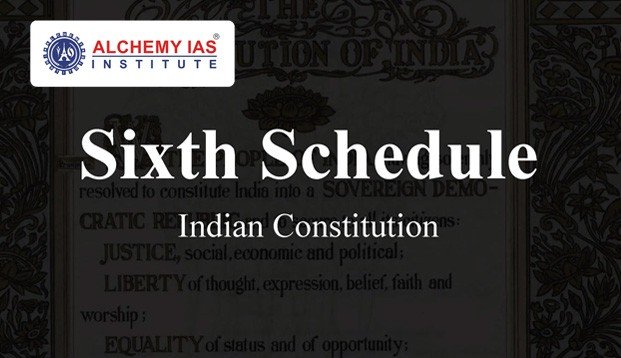
What is the Sixth Schedule?
- The Sixth Schedule, as per Article 244, establishes autonomous administrative divisions known as Autonomous District Councils (ADCs) within states.
- ADCs, typically comprising up to 30 members serving five-year terms, possess legislative, judicial, and administrative powers over various domains such as land, forest, water, agriculture, health, and social customs.
- Notably, the Bodoland Territorial Council in Assam differs, with over 40 members and jurisdiction over 39 issues.
- Applicability:
- The Sixth Schedule primarily applies to Northeastern states—Assam, Meghalaya, Mizoram, and Tripura.
Ladakh’s Interest:
- Initially, there was enthusiasm, particularly in Leh, following the August 5, 2019, decision to create two Union Territories. Leh, predominantly Buddhist, had long sought UT status due to perceived neglect by the previous state government.
- However, enthusiasm waned when it became clear that while Jammu and Kashmir UT would have a legislature, Ladakh UT would not.
- The absence of local legislative representation and governance by bureaucrats heightened feelings of detachment.
- Concerns also arose regarding changes in domicile policy in Jammu and Kashmir, sparking fears about land rights, employment, demography, and cultural identity in Ladakh.
Current Status:
- Ladakh currently operates with two Hill councils, neither of which falls under the Sixth Schedule.
- Their powers are limited, mainly to local tax collection and land use allocation.
Efforts for Inclusion:
- In September 2019, the National Commission for Scheduled Tribes recommended Ladakh’s inclusion under the Sixth Schedule, citing its predominantly tribal population, land ownership restrictions, and distinct cultural heritage.
- However, including Ladakh in the Sixth Schedule poses challenges, as the Constitution explicitly designates it for Northeastern regions.
- Yet, the government retains the authority to introduce a constitutional amendment bill for this purpose.
BHARAT RATNA
Syllabus: GS.2: Indian Polity – Awards in News
Why it’s in the News: Former Deputy Prime Minister L.K. Advani, will be awarded India’s highest civilian honor, the Bharat Ratna. Advani was previously honored with the Padma Vibhushan in 2015.
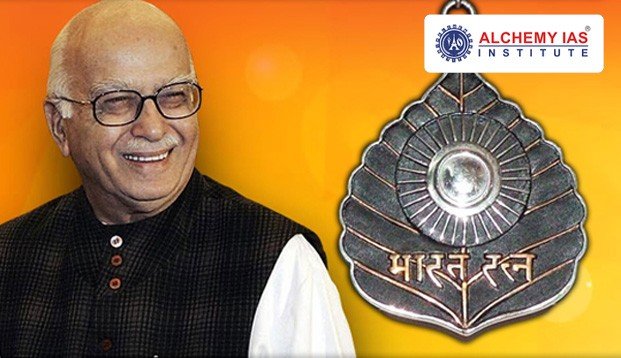
About Bharat Ratna:
- Instituted in 1954, Bharat Ratna is the highest civilian award of the country.
- It is awarded in recognition of exceptional service/performance of the highest order in any field of human endeavour.
- The recommendations for Bharat Ratna are made by the Prime Minister to the President of India.
- The number of Bharat Ratna Awards is restricted to a maximum of three in a particular year.
- National awards like Bharat Ratna, Padma Vibhushan, Padma Bhushan, and Padma Shri are not considered titles under Article 18(1) of the Constitution.
| News Plus: About Padma Awards Padma Awards were instituted in 1954 to be awarded to citizens of India in recognition of their distinguished contribution in various spheres of activity. Categories: Padma Vibhushan (exceptional service), Padma Bhushan (higher-order distinguished service), and Padma Shri (distinguished service).The government suspended the practice of granting the Padma awards for two years in 1977. It was again suspended during mid-1992 when PILs were filed in the High Courts of India. |
PERSONALLY IDENTIFIABLE INFORMATION (PII)
Syllabus: GS.2: Governance – E-governance
Why it’s in the News: The Ministry of Corporate Affairs addressed a critical vulnerability in its online portal, exposed by a cybersecurity researcher to CERT-In, revealing personal details of millions, including prominent figures.

What is Personally Identifiable Information?
- Personally Identifiable Information (PII) refers to data held by organizations or agencies that can potentially identify an individual.
- It encompasses various details like Aadhaar, PAN, voter identity, passport, date of birth, contact number, communication address, and biometric data, which can vary based on an individual’s country.
- Additionally, non-PII, when combined with other information, can also be used to identify individuals.
Sensitive vs. Non-sensitive PII
- Non-sensitive PII includes publicly available information like zip codes or gender, whereas sensitive PII, such as that stored by employers or government bodies, can lead to harm if exposed.
Risks of PII Exposure
- Exposure of PII due to cyberattacks or digital infrastructure weaknesses can result in targeted attacks, fraud, or identity theft.
- Threat actors may exploit this information for various malicious purposes, including phishing attacks and fraudulent financial activities.
Recent PII Compromises
- Notable instances of PII breaches include data leaks from the CoWIN portal and the RailYatri platform in India, leading to arrests and increased cyberattacks on government and essential service organizations.
Protecting PII
- Individuals can take proactive steps to safeguard their PII, such as ensuring secure website connections (HTTPS), using VPNs on public networks, and being cautious about sharing personal information on social media.
- Regularly monitoring bank accounts and credit scores can also help detect potential misuse of PII.
Way forward
- Protecting PII is critical to prevent identity theft and cyberattacks.
- Recent incidents highlight the urgency of robust security measures.
- By employing secure online practices and monitoring financial activities, individuals can reduce the risk of PII breaches.
- Collaboration among stakeholders is essential for enhancing cybersecurity resilience in our interconnected world.
GST APPELLATE TRIBUNALS
Syllabus: GS.2 & GS.3: Governance & Economy – Tax Reforms
Why it’s in the News: The much-awaited Goods and Services Tax (GST) Appellate Tribunals, intended to resolve taxpayer disputes under the six-and-a-half year’s old indirect tax regime, may begin operations around July or August.
- Currently, taxpayers resort to filing writ petitions directly to the High Court due to the absence of GST Appellate Tribunals. This adds strain to already burdened High Courts, which might lack specialized benches for GST matters.
- The absence of the GST Appellate Tribunal (GSTAT) results in a significant backlog of cases, delaying justice for aggrieved taxpayers.
- Without a dedicated tribunal, taxpayers have no alternative but to wait for justice while revenue authorities continue to pursue their orders aggressively.

About GST Appellate Tribunal (GSTAT):
- Section 109 of the Goods and Service Tax Act, 2017 (CGST Act) mandates the establishment of a GSTAT and its Benches.
- GSTAT serves as a specialized authority to resolve disputes related to GST laws at the appellate level.
- The principal bench of GSTAT will be situated in New Delhi, while the number of benches or boards for each state will be determined with GST council approval.
- Composition:
- Each bench will comprise two judicial members and two technical members, with the selection panel including a senior judicial member from the respective State High Court.
- The Tribunal is expected to be headed by a former Supreme Court judge or a former Chief Justice of a High Court.
- Powers of the Appellate Tribunal:
- Empowered by the Code of Civil Procedure, 1908, GSTAT holds equivalent powers as the court and is deemed a Civil Court for case adjudication.
- It possesses the authority to hear appeals, issue orders and directions, enforce orders, rectify mistakes, impose penalties, revoke or cancel registrations, and ensure compliance with GST laws.
- The framework may allow the resolution of disputes involving dues or fines of less than Rs. 50 lakh by a single-member bench, facilitating efficient dispute resolution.
Conclusion
- The establishment of Goods and Services Tax (GST) Appellate Tribunals marks a significant step towards efficient resolution of taxpayer disputes under the GST regime.
- With specialized benches and empowered adjudication, these tribunals promise to alleviate the burden on High Courts, expedite justice delivery, and ensure fair treatment for taxpayers while enhancing compliance with GST laws.

